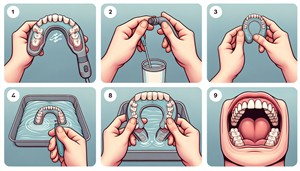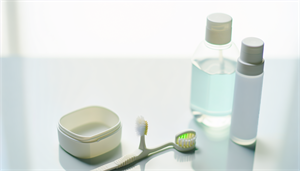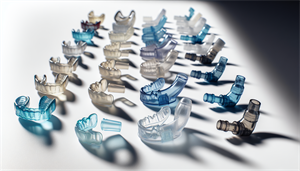Do you ever wake up feeling more tired than when you went to bed because of disrupted sleep due to snoring? Imagine the relief of experiencing restful sleep again, thanks to a simple device that can be customized right in your own home - the anti-snoring mouthpiece. Learning how to fit an anti snoring mouthpiece is an essential step towards achieving a peaceful night’s sleep.
Key Takeaways
-
Anti-snoring mouthpieces are an effective solution to reduce snoring.
-
There are two types of anti-snoring devices, and the FDA ensures safety by evaluating materials used for making them.
-
This article provides step by step instructions on how to fit a custom anti snoring mouthpiece for optimal comfort and effectiveness.
Understanding Anti Snoring Mouthpieces

Snoring, often deemed a mere nuisance, can significantly impact sleep quality and vary in snoring intensity. Addressing this issue can lead to more restful nights and improved overall health. One way to stop snoring is by using an anti-snoring mouthpiece, an effective remedy for preventing the soft throat tissues from collapsing and obstructing the airway during sleep. It is a small plastic device designed for this purpose. By holding the lower jaw slightly forward, this device opens up the respiratory tract, allowing for free airflow and relieving snoring.
A proper fit is vital for a mouthpiece to successfully reduce snoring. This means the device should hold the lower jaw forward comfortably and securely. Fortunately, these mouthpieces can be custom-fitted right at home, providing a personalized solution to snoring. The VitalSleep Mouthpiece, for example, is designed to conform to the user’s teeth and offers different bundles to cater to various needs.
Types of Anti Snoring Devices
Anti-snoring mouthpieces are classified into two types: Mandibular Advancement Devices (MADs) and Tongue Retaining Devices (TRDs). A mandibular advancement device, like the VitalSleep Mouthpiece, functions by holding the lower jaw slightly forward, promoting unobstructed airflow and reducing snoring. TRDs, on the other hand, hold the tongue forward to prevent it from falling back and blocking the airway during sleep.
Note that these snoring solutions differ from nightguards, which are designed to prevent teeth grinding and do not address snoring. By understanding these differences, you can choose the right device to effectively combat your snoring.
FDA Approved Materials
Mouthpieces are made from a variety of materials, but when it comes to safety and effectiveness, FDA-approved materials top the list. Using FDA-approved materials such as polycarbonate and EVA ensures the absence of harmful substances like latex or BPA plastic, making them latex free.
The FDA evaluates these materials using a special control guidance document that supports the classification of intraoral devices for snoring and obstructive sleep apnea. They assess and test these materials within a risk management framework and conduct physical properties testing to ensure compliance with regulations. This rigorous process guarantees that your mouthpiece is safe, effective, and long-lasting.
Preparing for the Molding Process

Proper preparation is key to molding your anti-snoring mouthpiece for a secure and comfortable fit. The VitalSleep Mouthpiece, for instance, incorporates a boil-and-bite method to create a personalized teeth impression. This process also includes the Accu-Adjust System for precise micro-adjustments, optimizing the mouthpiece’s position to match your snoring severity.
Ensure that the mouthpiece positions your lower jaw slightly forward while sleeping. This widens the respiratory tract and promotes unobstructed airflow, ultimately reducing snoring. By following the recommended steps and making necessary adjustments, you can achieve a perfect fit right in the comfort of your own home.
Items Needed
Having the right items on hand is crucial when preparing to mold your anti-snoring mouthpiece. You’ll need:
-
A medium-sized pot to boil water
-
A small bowl
-
A slotted spoon to safely retrieve the mouthpiece from the hot water
-
A stopwatch or a secondhand app to time the softening and molding process
While most of these items are likely already in your kitchen, the mouthpiece itself can be conveniently purchased online. The VitalSleep Mouthpiece, for example, is available for purchase through their official website. Following the recommended safety measures while handling these items during the molding process will ensure the best results and longevity of your device.
Cleaning Your Mouthpiece
The effectiveness and durability of your mouthpiece depend on maintaining its hygiene. Before and after the molding process, it’s important to clean the device thoroughly. Here are some effective cleaning methods:
-
Over-the-counter denture cleaners
-
A paste of baking soda and water
-
A mild dish soap solution
-
A mixture of vinegar and hydrogen peroxide
Remember to avoid harsh chemicals like bleach or alcohol, and always rinse the mouthpiece thoroughly after deep cleaning.
Regular cleaning, at least once a week, is recommended to ensure the hygiene and effectiveness of your mouthpiece. Proper cleaning not only prolongs the life of your device but also ensures you’re not introducing bacteria into your mouth.
Step-by-Step Molding Instructions

After preparing and cleaning your custom mouthpiece, initiate the molding process. This is where your anti-snoring mouthpiece becomes tailored to the unique shape of your mouth, ensuring maximum comfort and effectiveness.
First, boil water vigorously to soften the mouthpiece. The specific steps and techniques for the fitting process may differ among brands. For example, SnoreMeds and VitalSleep have distinct steps for their fitting processes.
After the water is heated, the next steps involve:
-
Softening the mouthpiece in hot water
-
Positioning it over the lower jaw
-
Moving the jaw into a comfortable forward position
-
Biting down firmly.
To finalize the shape, you can either place the warm mouthpiece into ice-cold water or run it under a cold tap. Both methods will help to set the shape. This will harden the material and fix the impression.
Heating the Water
Heating the water marks the first step in the molding process. The recommended temperature for heating water when molding an anti-snoring mouthpiece is a minimum of 170 degrees Fahrenheit. If a thermometer is not available, simply bring the water to a vigorous boil, as this will ensure it has reached the necessary temperature to soften the mouthpiece for molding.
The type of water, whether distilled, tap, or mineral, does not impact the molding process of an anti-snoring mouthpiece. The crucial factor is using hot water to effectively soften the mouthpiece material for molding. It’s also essential to avoid prolonged exposure of the mouthpiece to boiling water to prevent damage.
Softening the Mouthpiece
After the water is sufficiently heated, proceed to soften the mouthpiece. The recommended water temperature for this is approximately 170 degrees Fahrenheit or boiling vigorously. Soak the mouthpiece in the hot water for about 20 seconds to achieve softening.
A properly softened anti-snoring mouthpiece will be pliable and moldable, allowing for a comfortable fit in your mouth. This is a key step in ensuring your mouthpiece is effective in reducing snoring and promoting restful sleep, ultimately using the anti snoring mouthpiece successfully.
Positioning and Biting Down
With your mouthpiece softened, it’s time to position it in your mouth. Here’s how:
-
Submerge the mouthpiece in a cup of boiled water to soften it.
-
Place the softened mouthpiece in the center of your mouth.
-
Bite down on the mouthpiece for approximately 30 seconds.
-
Hold the mouthpiece in place to mold it to your teeth and jaw.
-
Rinse the mouthpiece with cold water to set the shape.
A secure and comfortable fit is vital for your mouthpiece’s effectiveness. It’s important to press the jaw together properly after fitting the mouthpiece and to clean your teeth before using it to prevent food particles from getting trapped. By following these recommended practices, you can ensure a proper fit for your anti-snoring device.
Creating a Tight Fit
A tight fit is vital for the effectiveness of your anti-snoring mouthpiece. Indicators of a properly fitting device include:
-
Comfort without pain or discomfort
-
Effective snoring reduction
-
Slight forward positioning of the jaw to maintain an open airway
-
Proper alignment with teeth without causing bite issues
-
Secure retention throughout the night
For some models like the VitalSleep Mouthpiece, you can achieve a more secure fit using the included adjustment tool. By turning each screw clockwise, you can bring the lower jaw forward, increase the airway opening, and secure a tighter fit. A snug fit ensures the mouthpiece remains securely in place, maintaining proper jaw and tongue alignment, which is vital for reducing snoring.
Finalizing the Shape
Once you’ve achieved a tight fit, proceed to finalize the shape of your mouthpiece. Here’s how:
-
Submerge it in boiled water to soften it.
-
Remove it from the water and let it cool slightly.
-
Place it in your mouth and bite down firmly.
-
Hold it in place for a few seconds to mold to your teeth and jaw.
-
Rinse it with cold water to set the shape.
Factors to consider when determining the final shape of your mouthpiece include:
-
Comfort
-
Fit
-
Jaw position
-
Adjustability
-
Future cleaning and maintenance
The correct final shape can be determined by evaluating proper sizing, comfort, custom fit, and the ability to make necessary adjustments.
Following these steps, the finalization process typically takes a few minutes, ensuring a customized mouthpiece that will provide you with restful sleep.
Adjustments and Troubleshooting

Post-molding, your mouthpiece may need adjustments or troubleshooting over time. Here are some steps you can take:
-
Soften the mouthpiece in hot water.
-
Bite down on the mouthpiece to make a more precise impression.
-
Make necessary adjustments to the fit.
-
If you’re experiencing discomfort, consider readjusting the fit, gradually acclimating to it by wearing it for short intervals, or performing jaw exercises to reduce tension.
Keep in mind that not all anti-snoring mouthpieces are adjustable. Some are designed with customizable features to fit different mouth shapes, while others have a fixed design that cannot be altered.
Refitting the Mouthpiece
At some point, you may need to refit your mouthpiece. Indications that your anti-snoring mouthpiece may require refitting include:
-
Tooth or jaw muscle ache
-
Jaw joint pain
-
Excessive forward positioning of the lower jaw
-
Inadequate proximity to the lips
-
Noticeable deep teeth marks on the device
Refitting your anti-snoring mouthpiece is a simple process that involves the following steps:
-
Clean the mouthpiece.
-
Heat the mouthpiece in hot water.
-
Dip the mouthpiece in cold water.
-
Bite down to mold the mouthpiece.
-
Let the mouthpiece cool and set.
However, it’s recommended to refit your mouthpiece every 3 to 5 nights to ensure optimal comfort and effectiveness.
Caring for Your Mouthpiece

The longevity of your mouthpiece depends on proper care and maintenance. Clean the device using a soft-bristled toothbrush and warm water, ensuring that every part of the mouthpiece is thoroughly cleaned. Avoid abrasive substances like toothpaste as they can cause scratches on the device, leading to accelerated wear and tear.
When your mouthpiece is not in use, store it in a clean and dry container to preserve its hygiene and structural integrity. Regular maintenance not only extends the life of your device but also ensures its effectiveness in reducing snoring and promoting restful sleep.
Identifying the Right Candidate for an Anti Snoring Mouthpiece
Although effective for many, anti-snoring mouthpieces may not suit everyone. Individuals with health conditions such as temporomandibular joint (TMJ) disorders, poor dental health and hygiene, and certain dental side effects may not be suitable candidates for using anti-snoring mouthpieces.
Furthermore, individuals who suspect they have Obstructive Sleep Apnea should seek advice from a physician before considering the use of any anti-snoring devices. Age is also a factor when considering the use of anti-snoring mouthpieces. While these mouthpieces are beneficial for snorers across all age groups, individuals under the age of 18 should refrain from using them.
Exclusions
Anti-snoring mouthpieces may be unsuitable for some individuals. They may not be suitable for individuals with:
-
TMJ disorders
-
Poor dental health
-
Missing teeth
-
Dentures
-
Specific dental diseases
These conditions can impede the use of anti-snoring mouthpieces.
Furthermore, individuals under the age of 18 are advised not to use these devices, as they may use cookies and data.
For those who grind their teeth, anti-snoring mouthpieces can still be safely used. Many anti-snoring mouthpieces include a nighttime grinding guard, which can help alleviate:
-
muscle tension
-
separate the jawbones
-
enhance airflow and breathing
-
provide protection against teeth grinding.
Comparing Popular Anti Snoring Mouthpieces
The market offers numerous anti-snoring mouthpieces, all with unique features and benefits. Some of the top-rated anti-snoring mouthpieces currently on the market include:
The cost of these mouthpieces usually falls between $50 and $150, making them an affordable solution for many people struggling with snoring. By comparing the features, benefits, and price points of these popular products, you can make an informed decision on which mouthpiece is the best fit for you.
Summary
In conclusion, anti-snoring mouthpieces offer a simple yet effective solution to reduce snoring and promote restful sleep. From understanding the mechanisms of anti-snoring mouthpieces and the molding process to making adjustments and caring for your device, this guide provides comprehensive information that can help you achieve a good night’s sleep.
Remember, selecting the right mouthpiece and ensuring a proper fit are crucial for the effectiveness of the device. So, invest in your health and sleep quality by choosing the right anti-snoring mouthpiece that suits your needs.
Frequently Asked Questions
How do you wear an anti snore ring?
To wear an anti-snore ring, place it on the little finger of your right hand if you're male, or the left hand if you're female, and position it towards the bottom of the finger for a comfortable fit. Squeeze and release the sides gently to ensure it's snug but not too tight.
How long does it take to get used to a snore guard?
It can take up to three weeks to get used to a snore guard, so it's important to be patient during this adjustment period.
What is an anti-snoring mouthpiece and how does it work?
An anti-snoring mouthpiece is a small plastic device that prevents soft throat tissues from collapsing during sleep. It works by holding the lower jaw slightly forward, allowing the respiratory tract to open up and air to flow freely, which helps relieve snoring.
What materials are used in anti-snoring mouthpieces?
Anti-snoring mouthpieces are made from FDA-approved materials such as polycarbonate and EVA, which are latex-free and biocompatible. These materials ensure the absence of harmful substances.
How do I mold my anti-snoring mouthpiece for a custom fit?
To mold your anti-snoring mouthpiece for a custom fit, start by heating water, softening the mouthpiece in the hot water, then positioning it in your mouth over the lower jaw, and biting down firmly in a comfortable forward position. After that, finalize the shape by placing the warm mouthpiece into cold water.


